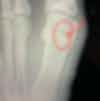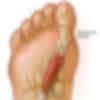What is a Sesamoid Bone and Why All Runners Should Care
By: Kali Smolen
I had high hopes of writing a newsletter piece about the marathon I ran in August, but instead I’m writing about my injury story. I successfully completed the Green River Marathon- even qualifying for Boston, which is probably in my top three proudest moments in life so far! I was so excited to see how the training was paying off. Never in my life did I think running ten miles would be “easy.” But right before the marathon, I started to notice some pain in the ball of my foot. I could shorten my stride and increase my cadence to make the pain go away, which is how I managed to run the marathon. My physical therapist thought it was sesamoiditis, which it very well could have been at that point. I started massaging my feet, rolling them out with a ball, and adjusting my stride to protect the ball of my foot. But into the fall months, the pain wasn’t going away. I was still running on it, and it was actually knee pain that caused me to see a doctor about it. The knee pain was probably caused by an altered gait to avoid hurting my foot. That is when we took some foot x-rays and saw the fractured sesamoid.
You’re probably wondering, what is a sesamoid? I usually say I have a broken toe. But what is actually broken is a tiny sesamoid bone. Most people have two of them: a medial sesamoid and a lateral sesamoid. Some people have three or even four. These are tiny floating bones in the ball of your foot that attach to tendons for the muscle of the big toe. They are the size of a pea. They provide leverage when the toe is pushing off of the ground and absorb some weight when running or walking. Because of their function, they are usually injured in sports like running or dancing where there is repetitive foot stress. A sesamoid can fracture acutely or chronically. With an acute fracture, there is swelling, pain, and even bruising. With a chronic fracture caused over time by repetitive stress, there is usually intermittent pain and no swelling. As such, it is usually diagnosed as sesamoiditis.
Once we saw the fracture line, I stopped running. I had a hard time accepting that rest was how I’d get better. Sometimes, I still struggle with this- more than I’d like to admit. I got a pool membership, focused on strengthening the core, and have tried to remain positive despite missing a season of skiing. And in the meantime, I have read all sorts of articles about this tiny bone and identified ways to prevent this from happening again. Here are some tips to avoid a sesamoid fracture:
- Strengthen your feet! So often as runners, we focus on the quads, hamstrings, hip flexors, calves, but we ignore the feet. There are lots of little muscles in the feet that need to be supported to prevent stress fractures like mine. Some good strengthening exercises are picking up a washcloth with your feet, raising the big toe only and then the little toes separately, standing on your toes and slowly lowering, etc. Fullerrunsfar on Instagram has lots of great tips for full body strengthening for runners. More foot tips can be found here: https://www.medicalnewstoday.com/articles/320964#foot-health-and-safety-tips
- Strength train! And include your feet. Given that strength is the top two, I can't emphasize it enough. If you have stronger muscles, you'll be able to run more efficiently, which will put less strain on your musculoskeletal system and decrease your risk of injury.
- If you have any foot pain, address the problem early. Your shoes probably won’t magically feel better after 50 miles of running in them. Rather, try a new shoe and avoid unnecessary strain on feet bones. Consider orthotics if you need them. Orthotics don’t make you weak. They make you smart (if you need them). And remember, shoes are less expensive than physical therapy and orthopedic visits. Trust me.
- Stretch your feet too. After a run or when you wake up in the morning, roll your feet on a lacrosse ball or something of that sort. Stretch your toes out by wearing toe spacers if you want to.
- Prioritize nutrition. I’ve started taking calcium, vitamin D, and a multivitamin. Running takes a lot of micro and macronutrients. Happy to talk more about this if you have questions! This is a huge interest of mine, and I'm hoping to do a nutrition fellowship after medical school.
- Cross train! Don’t only run. Try biking, swimming, skiing, hiking, etc. to switch up which muscles you’re using. It will actually help you run in the long run! Repetition is hard on tiny bones.
Hope you’re able to learn something from my story to prevent an injury story in your life. I hope to be back running soon! But to be honest, sesamoids don’t heal quickly. Average healing time for a fracture that hasn’t healed in the first 15 weeks is 1-2 years. I’m hoping to avoid surgery, so you’ll be seeing me on a bike this season. Happy running! Be safe out there. Take care of those feet!








